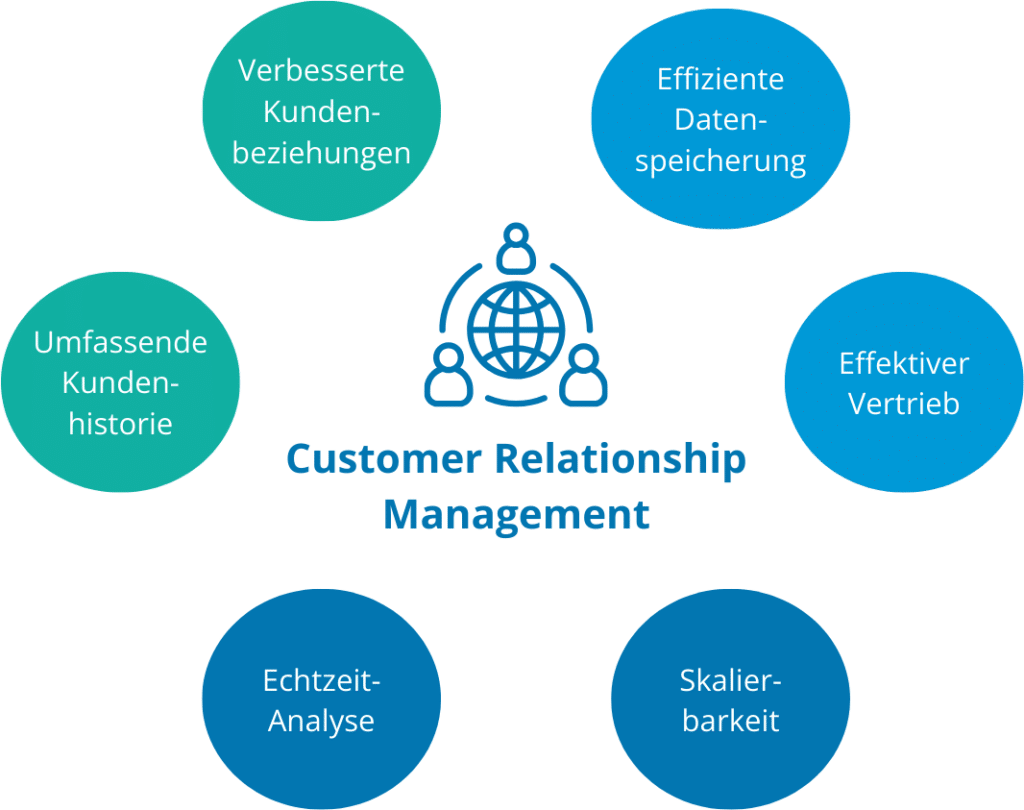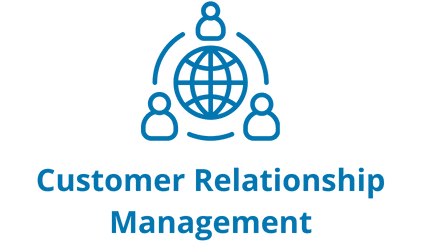Von Daten zu Beziehungen: Wie das richtige CRM den Unterschied macht.
In der Ära der digitalen Transformation, in der Kundenbeziehungen den entscheidenden Unterschied für den Geschäftserfolg ausmachen, spielt Customer Relationship Management (CRM) eine zentrale Rolle. Die Art und Weise, wie Unternehmen mit ihren Kunden interagieren und Beziehungen aufbauen, hat sich in den letzten Jahren dramatisch verändert. Kunden erwarten personalisierte Erlebnisse, maßgeschneiderte Lösungen und eine nahtlose Kommunikation. Dieser Artikel erkundet die Schlüsselherausforderungen und Chancen im modernen Kundenbeziehungsmanagement, hebt die Vorteile einer digitalen CRM-Lösung hervor und wirft einen genaueren Blick auf innovative Ansätze, die Unternehmen dabei unterstützen, Kundenbeziehungen auf eine neue Ebene zu heben. Tauchen Sie ein in die Welt des Customer Relationship Managements und entdecken Sie, wie die richtige Strategie und Technologie den Weg für langfristige, erfolgreiche Kundenbindungen ebnet.
Um 34%
steigt die Produktivität des Sales-Teams bei der effektiven Nutzung eines Customer Relationship Management Systems.
Laut diesem Trend Report lohnt sich also der Einsatz eines Customer Relationship Management Systems.
Herausforderungen des CRM für KMU
Begrenzte Ressourcen
KMU verfügen oft über begrenzte finanzielle und personelle Ressourcen. Die Implementierung und Pflege eines CRM-Systems kann daher eine finanzielle und personelle Belastung darstellen.
Mangelnde Datenqualität
Oftmals haben KMU Schwierigkeiten, qualitativ hochwertige Kundendaten zu sammeln und zu pflegen. Unvollständige oder veraltete Daten beeinträchtigen die Effektivität des CRM und führen zu ungenauen Analysen.
Fehlende Expertise
KMU haben möglicherweise nicht die interne Expertise, um komplexe CRM-Systeme optimal zu nutzen. Das Schulen von Mitarbeitern und die Sicherstellung eines Verständnisses für die Funktionalitäten sind entscheidend.
Anpassung an individuelle Bedürfnisse
Jedes Unternehmen hat einzigartige Anforderungen. Die Herausforderung besteht darin, ein CRM-System zu finden oder anzupassen, das genau den spezifischen Bedürfnissen des KMU entspricht.
Akzeptanz durch die Mitarbeiter
Die Einführung eines CRM-Systems erfordert die Zusammenarbeit aller Mitarbeiter. Die Akzeptanz und Bereitschaft zur Nutzung des Systems können eine Herausforderung darstellen.
Datenschutz und Compliance
Der Umgang mit Kundendaten erfordert eine sorgfältige Beachtung von Datenschutzbestimmungen und Compliance-Richtlinien. KMU müssen sicherstellen, dass ihr CRM-System diesen Standards entspricht.
Kundenservice-Optimierung
Die Umsetzung eines effektiven Kundenservice im Rahmen des CRM erfordert klare Prozesse und schnelle Reaktionszeiten, was für kleinere Unternehmen mit begrenzten Ressourcen eine Herausforderung sein kann.
Die Symbiose von Technologie und Vertrauenswürdigkeit in Kundenbeziehungen
Unternehmen stehen vor der Herausforderung, innovative Technologien zu nutzen, um Kundenerlebnisse zu verbessern, während sie gleichzeitig das Vertrauen ihrer Kunden gewinnen und pflegen müssen.
In einer Zeit, in der Technologie den Ton angibt, ist die Herausforderung für Unternehmen nicht nur, innovative Werkzeuge einzusetzen, sondern auch, eine authentische und vertrauenswürdige Verbindung zu ihren Kunden aufzubauen. Denn echte Beziehungen erfordern mehr als automatisierte Nachrichten – sie brauchen den persönlichen Touch.
Technologie als Verbindungselement:
Moderne Kommunikationsmittel ermöglichen es Unternehmen, in Echtzeit mit ihren Kunden zu interagieren. Doch während E-Mails, Chatbots und automatisierte Antworten effizient sind, darf der menschliche Aspekt nicht vernachlässigt werden. Technologie sollte als Mittel zur Verbesserung der Kommunikation dienen, nicht als Ersatz für den persönlichen Kontakt.
Die Bedeutung des Persönlichen:
In der digitalen Welt, in der wir uns bewegen, sehnen sich Kunden nach persönlicher Aufmerksamkeit. Der persönliche Kontakt, sei es in Form von Telefonanrufen, Videokonferenzen oder persönlichen Treffen, schafft eine menschliche Verbindung, die maschinelle Interaktionen nicht ersetzen können. Unternehmen sollten Wege finden, diese persönliche Note zu bewahren.
Vertrauen durch Authentizität:
Vertrauen entsteht durch Authentizität. Unternehmen sollten nicht nur transparent über ihre Produkte und Dienstleistungen kommunizieren, sondern auch über ihre Werte und die Menschen hinter der Marke. Authentische Geschichten und Einblicke in den Arbeitsalltag können eine tiefere Verbindung zwischen Unternehmen und Kunden schaffen.

Mit digitalem CRM zum Erfolg
Ein digitales Customer Relationship Management (CRM) ist zweifellos die Schlüssellösung für Unternehmen, die sich nach nahtlosen Transaktionen, effizientem Vertrieb und nachhaltigen Kundenbeziehungen sehnen. Die Herausforderung, alle relevanten Ressourcen an einem Ort bereitzustellen, wird durch ein digitales CRM mühelos bewältigt.
Die essentiellen Elemente, von der Lead-Generierung über das Pipelinemanagement bis zur gemeinsamen Bearbeitung von Vertriebsdokumenten, werden übersichtlich in einem zentralen System zusammengeführt. Dies ermöglicht nicht nur eine optimale Nutzung von Informationen, sondern schafft auch Raum für Ihre Vertriebsmitarbeiter, um starke Beziehungen zu ihren Kunden aufzubauen.
Die umfassende Lösung eines digitalen CRM-Systems automatisiert zeitraubende Aufgaben und ermöglicht es Ihrem Team, sich auf die Pflege von Kundenbeziehungen zu konzentrieren. Mit einer intuitiven und benutzerfreundlichen Anwendung bietet es eine ganzheitliche Übersicht über Ihre Kunden, unterstützt die Transformation von Daten aus umfangreichen Mengen und wandelt sie in umsetzbare Insights um.

- Verbesserte Kundenbeziehungen durch umfassendes Verständnis der Bedürfnisse
- Effiziente Verwaltung von Kundendaten durch eine zentrale Plattform
- Umfassende Kundenhistorie durch das Sammeln von Daten über Interaktionen und Transaktionen
- Effektiver Vertrieb durch das Optimieren von Verkaufsprozessen und Nachverfolgen von Verkaufsaktivitäten
- Gezieltere Marketingstrategien durch die Analyse von Kundenverhalten und Präferenzen
- Effizientes Kundenservice-Management durch bessere Organisation der Support-Anfragen, automatisierten Kundenservice und eine verkürzte Reaktionszeit
- Höhere Kundenzufriedenheit durch gezieltere Ansprache sowie schnellere und persönlichere Betreuung
- Fundierte Entscheidungen dank Echtzeit-Analyse von aktuellen Trends, Leistungen und Engpässen
- Skalierbarkeit des Systems und Anpassung an das Wachstum des Unternehmens
- Wettbewerbsvorteil durch die effektive Nutzung von Kundeninformationen und die Optimierung von Geschäftsprozessen

Funktionen der Microsoft Lösungen für Ihr Customer Relationship Management
Dynamics 365 Sales: Vertriebspower im Zeitalter der KI
Microsoft Dynamics 365 Sales bietet nicht nur eine Produktivitätssteigerung im Vertrieb durch simultane Zusammenarbeit und Integration mit Outlook, sondern auch tiefgreifende Einblicke mittels prädiktiver Leadbewertung durch künstliche Intelligenz. Diese Funktionen ermöglichen es Vertriebsmitarbeitern, potenzielle Kunden effizienter zu identifizieren und zu betreuen.
Microsoft 365: Zusammenarbeit neu definiert für unschlagbare Ergebnisse
Microsoft 365 erleichtert die unternehmensweite Zusammenarbeit und Kommunikation. Die Integration von Angeboten und Pitch Decks auf SharePoint sowie Gruppenchats über Microsoft Teams fördert einen reibungslosen Informationsaustausch im Team. Dadurch können Vertriebsmitarbeiter effektiver zusammenarbeiten und Kundenanfragen schneller bearbeiten.
Dynamics 365 Customer Service: Kundenservice der Zukunft – Automatisierung trifft Individualität
Microsoft Dynamics 365 Customer Service automatisiert zentrale Vertriebsfunktionen und gewährleistet, dass Vertriebsmitarbeiter mehr Zeit haben, sich auf die individuellen Bedürfnisse ihrer Kunden zu konzentrieren. Durch die Automatisierung von Geschäftsprozessen können Kundenanfragen schneller und präziser bearbeitet werden, was zu einer verbesserten Kundenzufriedenheit beiträgt. Diese digitalen Lösungen bilden somit eine umfassende Basis für die effektive Verwaltung und Pflege von Kundenbeziehungen, indem sie den gesamten Vertriebszyklus abdecken.


